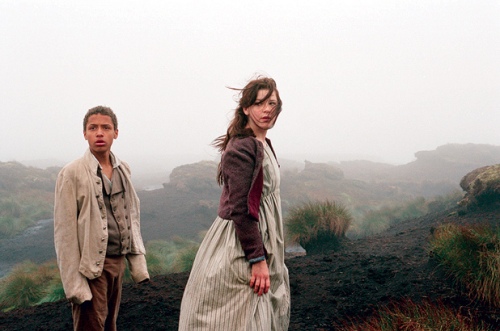A few notes on some recently watched films:
Hors Satan [Outside Satan], (Bruno Dumont, France, 2011): A most unusual couple—dubbed only The Guy (David Dewaele) and The Girl (Alexandra Lamatre)—traipse around a coastal village in northwestern France in this slow-moving yet entrancing drama. Despite his professed atheism, Dumont has show an interest in spirituality throughout his career.Hors Satanarrives as his most outwardly metaphysical film, but it stays grounded in the sort of naturalism that’s driven a stern wedge between his detractors and his admirers for years.
The ambiguous narrative suggests The Guy possesses some sort of supernatural ability, but Dumont, as is his wont, is more concerned with action that exposition. The character’s motives are shrouded in mystery, easily discerned as either sadistic or benevolent. Toward the end of the film, he pulls off some downright miraculous stuff. Each of these moments unfold with as little fanfare as possible, with Dumont sticking closely to his naturalistic aesthetic. He had dabbled in the mythical and metaphysical before, but Hors Satan reaches planes hitherto unseen in his work. As a result, the film emerges as perhaps the purest expression of his most overriding theme: that life and nature are brimming with sanctity, and the supposed existence of God only alienates the individual from readily experiencing it. The film is lyrical, humanistic, disturbing, and devastating in equal measure.
Formally, Hors Satan is vintage Dumont. His minimalist approach to sound design is Bressonian in nature: a single track captures literally everything—dialogue and ambient sound are culled together, placing the viewer directly into the setting to ensure a most intimate viewing experience. [A]
Jeff, Who Lives at Home (Mark and Jay Duplass, U.S., 2012): In the case of the Duplass Brothers, as their crews and ambitions have grown larger, the quality of their work has diminished considerably. The consumer grade aesthetic of their first two films (2005’s The Puffy Chair and 2008’s Baghead) made for an unpretentious, occasionally cathartic film style that has since been labeled “mumblecore.” In relying heavily on improvisation from their non-actors and keeping their modes of production on a decidedly DIY level, the Duplass Brothers seemed to be on the cutting edge of digitally-created cinema, declaring it a most democratic form of filmmaking.
Unfortunately, the allure of Hollywood drove the Duplass’ to more lofty projects. For Cyrus (2010), such apparent luxuries as professional actors and an inflated budget actually inhibited the unique voice present in their earlier work. Their approach to characterization was hit the hardest. Before, the non-actors in their films made for wider channels of interaction with the audience: because these actors were “nobodies,” they could, essentially, be “anybody.” The audience was free to find themselves in the film and thus relate to it more closely. Casting John C. Reily and Jonah Hill made practical sense, but their presence (and reputations) overshadowed any sort of universality that might have otherwise existed in their characters.
Enter Jeff, Who Lives at Home, which again finds the Duplass’ using professional actors (Jason Segal, Ed Helms, and Susan Sarandon among them) and a decidedly controlled visual style. The film’s cinematography has a very deliberate presence, evoking warm colors and deep shadows. While it’s certainly appealing to look at, it doesn’t match the Duplass’ documentary-esque camera movements. They use quick, jerky zooms to accentuate the screenplay’s emotional beats (freely borrowing from a similar, far more successful method used by Tony Scott) and give the film a more improvisational tone.
But they can’t have their cake and eat it, too. Jeff, Who Lives at Home, though occasionally funny, is a flimsy and thematically weightless film. The Duplass’ films have always bore the marks of their upbringing (upper-middle class, suburban, white), but when they operated on a smaller scope, it was easy to forgive their blandly optimistic themes. The chipper refrain of “What’s the greatest day in the history of the world? Today is the greatest day in the history of the world” is, on the surface, a perfectly fine sentiment, but it fails to account for the true nature of the world outside of the Duplass’ sunny milieu.
For instance, if, on February 26, they had told the family of Trayvon Martin that, “Today is the greatest day in the history of the world,” they’d likely receive a hearty, “Fuck you,” in return. [C-]
Wuthering Heights (Andrea Arnold, U.K., 2011): Taking an already notoriously maudlin story and instilling some of her own lurid preoccupations, Andrea Arnold’s latest film is an adaption of Emily Brontë’s Gothic romance. Plenty of directors have taken a stab at Wuthering Heights: William Wyler’s 1939 film remains the widely recognized, though Luis Bunuel’s delightfully deconstructionist version stands as perhaps the most radical re-imagining. Arnold’s version doesn’t owe much to either film, however.
Among the most distinct departures from the source material is a decidedly grimier tone. The doomed romance between Heathcliff (portrayed here by a black actor, the film’s other radical shift) and Catherine undergoes a psycho-sexual evaluation by Arnold. An early scene in which the two children wrestle around in a pile of mud begins innocently enough, only to move into a licentious game of cat-and-mouse that ends with Heathcliff straddling Catherine while rubbing dirt on her face—and she, in turn, willing subjecting herself to the abuse. Of course, their relationship only grows more deranged as they transition into adulthood. The film’s weakest moments arise when Arnold, who has a clear fixation on the dysfunctional relationship detailed in Brontë’s text, injects salaciousness of her own design into some of the story’s key scenes.
With that said, Arnold is wise to limit her focus in this way. The worst adaptations of Wuthering Heights are the ones that attempt to compress the novel’s myriad themes into a two-hour run time. It’s no coincidence that most of them excise the novel’s second half (which details the story of the children of Heathcliff, Catherine and others) and key in on a particular element as opposed to several—Bunuel, for instance, took interest in the novel’s depiction of class struggle, giving it a pseudo-Marxist examination while also being highly erotic, in the Bunuelian sense.
Arnold takes the social themes of Wuthering Heights into account, though does so in the same sort of kitchen-sink drama fashion as her previous works. Somewhat defiantly, she subverts the conventions of the classic novel and makes them fit her own vision. While it may not always work, the audacity is admirable—and a far cry better than Cary Fukunaga’s complacent Jane Eyre (2010). [B]
Alps (Yorgos Lanthimos, Greece, 2011): Few films have left me as shaken as Dogtooth (2010), a disturbingly pitch-black comedy about the deranged lives of a nuclear family. But while it’s followup, Alps, treads similar thematic grounds—Lanthimos continues his attraction to forged identities, human violence, and American pop culture—the film lacks the sort of energetic thrust of ambiguity that made Dogtooth such a kick in the ass.
The film tells the story of four individuals (calling themselves Alps) who help mourning family members recover from their grief by standing in as their recently departed loved ones. In a way, the characters are Lanthimos’s answer to what could happen to the children of Dogtooth once they enter the outside world: unable to cope with their own realities, they co-opt other realities in order to navigate a treacherous world, burdening the illusion in such a way that evokes Hitchcock’s obsession with duality and surrogates. But rather than advancing this theme, Lanthimos appears content with resting on his laurels. As a result, Alpsis quite easily digestible. It even follows a more conventional narrative arch as it follows its protagonist (Dogtooth‘s Aggeliki Papoulia) and her gradual unraveling.
Still, as an emerging voice, Lanthimos remains an exciting filmmaker and appears well on his way to becoming a vital presence in the international art house. His distinct visual qualities—he has a penchant for shooting his actors from behind or just out frame to ensure that we never quite see them—go far enough to keep Alps interesting from scene to scene. This is particularly helpful when Lanthimos becomes predictable: A climactic moment, in which one character places Papoulia’s fate on whether or not a bowling pin will changes colors, culminates precisely as you expect, but some precise framing and intricate composition give the scene a formal beauty that belies the grueling action.
This scene and those like it prove that one doesn’t watch a Lanthimos film as much as one endures it. The results are satisfying if you can stand the heat. [B+]




